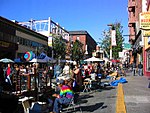Zellerbach Hall

Zellerbach Hall is a multi-venue performance facility on the campus of the University of California, Berkeley, west of Lower Sproul Plaza. It was designed by architect and professor Vernon DeMars and completed in 1968. The facility consists of two primary performance spaces: the 1,984-seat Zellerbach Auditorium, and the 500-seat Zellerbach Playhouse. Zellerbach Auditorium is the main performance venue for Cal Performances, a presenting and producing arts organization. The facility is suitable for dance, theater, and opera, and has a built-in concert shell that provides an excellent acoustical enclosure for symphonic and other classical music performances. The Playhouse is primarily used by the UC Berkeley Department of Theater and Dance. It features flexible seating sections to allow for different configurations of the seating and performance spaces. Zellerbach Hall was named in honor of Isadore and Jennie Zellerbach, after a $1 million gift was given toward completion of the facility.Christine McVie of the band Fleetwood Mac recorded her song "Songbird" (from the album Rumours) here in 1976.In May 1998, the game show Jeopardy! held their annual College Championship at Zellerbach Hall.
Excerpt from the Wikipedia article Zellerbach Hall (License: CC BY-SA 3.0, Authors, Images).Zellerbach Hall
Lower Sproul Plaza, Berkeley
Geographical coordinates (GPS) Address External links Nearby Places Show on map
Geographical coordinates (GPS)
| Latitude | Longitude |
|---|---|
| N 37.868888888889 ° | E -122.26083333333 ° |
Address
Zellerbach Hall
Lower Sproul Plaza
94704 Berkeley
California, United States
Open on Google Maps








